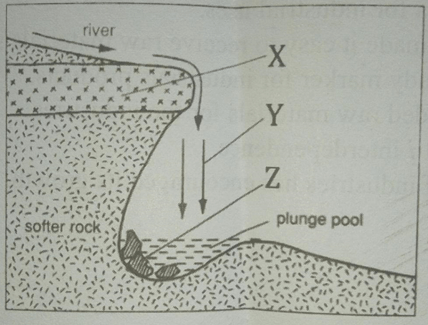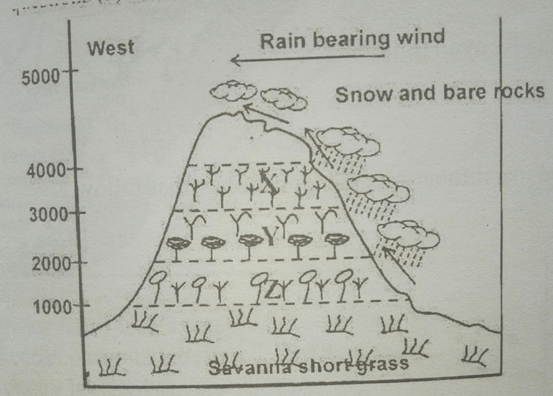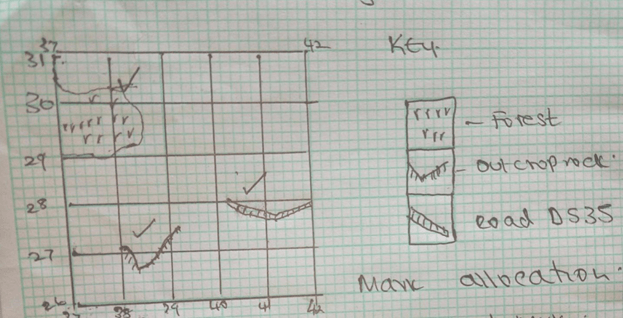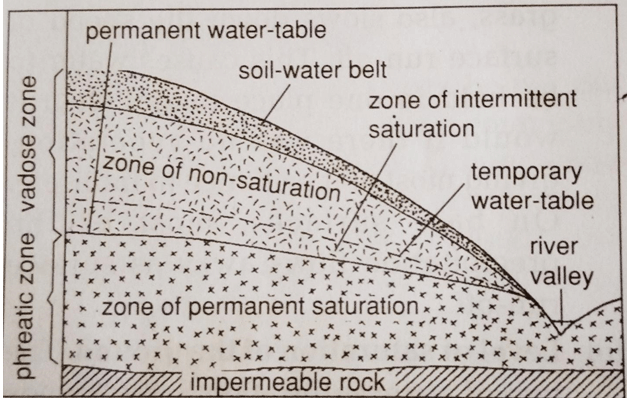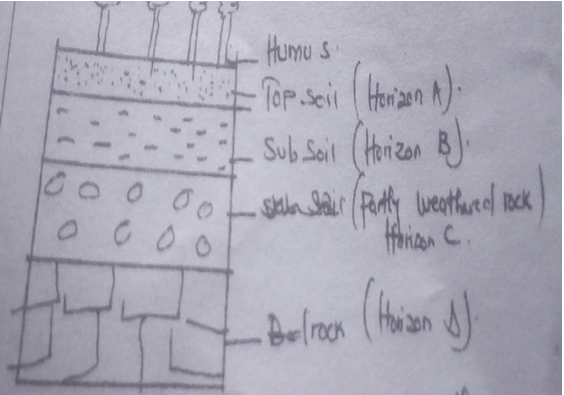GEOGRAPHY
PAPER 1
FORM 4 TERM 1 OPENER EXAMS
TIME: 2¾ HOURS
INSTRUCTIONS TO CANDIDATES
- This paper has two sections Aand B
- Answer all questions in section A
- In section B answer question 6 and any two questions
- All answers must be written in English
SECTION A
ANSWER ALL THE QUESTIONS IN THIS SECTION
-
- What is the difference between a meteor and a meteorite (2mks)
- State three effects of earth’s revolution (3mks)
-
- List two elements of weather(2mks)
- Name three processes through which the atmosphere is heated (3mks)
-
- What is weathering (2mks)
- Give three processes of chemical weathering (3mks)
-
- Name three types of coral reefs (3mks)
- What are the benefits of coral reefs in the areas they have developed (2mks)
-
- State two factors which influence occurrence of surface run-off (2mks)
- The diagram below shows a waterfall. Name the features marked X,Y, and Z (3mks)
SECTION B
ANSWER QUESTION 6 AND ANY OTHER TWO QUESTIONS FROM THIS SECTION
- Study the map of Taita hills(scale 1:50.000) provides and answer questions while follows.
-
- Give the latitudinal position of the South Eastern corner of the map extract (2mks)
- State the four figure grid reference of the school at Mrabenyi (1mk)
- Identify the adjoining sheet number to the S.E of Taita hills (1mk)
-
- Measure the length of dry weather road D535 from the junction at grid 4028 to the east of the map (2mks)
- Calculate the area enclosed by the railway line to the south Eastern part of the map (2mks)
-
- Reduce the square enclosing Easting 37 to 42 and Northing 26 to 31 by 2, on the reduce square indicate the following.
- Ronge forest
- Road D535
- Outcrop rock (5mks)
- Give the new scale of the reduced square (2mks)
- Reduce the square enclosing Easting 37 to 42 and Northing 26 to 31 by 2, on the reduce square indicate the following.
-
- Describe the drainage of the area covered by the map (4mks)
- Identify two methods of representing relief used in the map extract (2mks)
- Citing evidence from the map give two economic activities carried out (4mks)
-
-
-
- What is artesian well? (2mks)
- List four conditions necessary for the formation of an artesian well.(4mks)
-
- With the aid of a well labeled diagram, describe the three zones of underground water(6mks)
- Identify three sources of underground waters (3mks)
- Explain three ways in which a Karst landscape would influence human activities (6mks)
- Your class intends to carry out a field study on limestone area near your school
- Name two surfaces features you are likely to identify (2mks)
- State two problems you are likely to identify (2mks)
-
-
-
- Define the term glaciation 2mks
- Name three types of glaciers 3mks
- Describe how the following features found in upland glaciated landscape are formed
- U-shaped valley(5mks)
- Pyramidal peak (5mks)
- Explain three significance of upland glaciated features to human activities(6mks)
- Suppose you were to carry out a field study of a glaciated lowland
- State two advantages of using oral interview to collect information during the field study(2mks)
- Name two features found in glaciated lowlands that you are likely to study (2mks)
-
-
-
- Differentiate between a soil profile and soil catena(2mks)
- Draw a well labeled diagram of a mature soil profile(4mks)
-
- Other than topography name three factors that influence formation of soil(4mks)
- Explain how topography influences formation of soil (3mks)
- List three characteristics of desert soils (3mks)
-
- Give three types of soil erosion (3mks)
- Explain three effects of soil erosion on human activities (6mks)
-
-
- The diagram below represents zones of natural vegetation on a mountain within tropical regions, use it to answer questions (a) and (b)
- Name the vegetation zones marked X,Y and Z (3MKS)
- Give two reasons why the mountain top has no vegetation (2mks)
- Describe the characteristics of savanna grasslands (4mks)
- Explain four factors that have led to the decline of natural grassland in Kenya (8mks)
- You carried out a field study of different tree species
- Identify three activities you would carry out during the field study(3mks)
- How would you identify the different tree species?(3mks)
- State two methods you would use to determine the height of the trees (2mks)
- The diagram below represents zones of natural vegetation on a mountain within tropical regions, use it to answer questions (a) and (b)
MARKING SCHEME
SECTION A
ANSWER ALL THE QUESTIONS IN THIS SECTION
-
- What is the difference between a meteor and a meteorite (2mks)
- Meteor-is a streak of light seen in the sky in a clear night and occurs as a result of meteoroid burning as it enters earth’s atmosphere while a meteorite is a meteoroid which has not completely burnt up and manages to reach the earth’s surface.
- Meteor-is a streak of light seen in the sky in a clear night and occurs as a result of meteoroid burning as it enters earth’s atmosphere while a meteorite is a meteoroid which has not completely burnt up and manages to reach the earth’s surface.
- State three effects of earth’s revolution (3mks)
- Revolution causes the four seasons-summer, autumn, winter and spring
- Revolution causes changes in the position of the midday sun at different times of the year.
- Revolution causes varying length of day and night at different times of the year
- Revolution causes the lunar eclipse
- What is the difference between a meteor and a meteorite (2mks)
-
- List two elements of weather(2mks)
- Temperature
- Air pressure
- Precipitation
- Humidity
- Wind
- Sunshine
- Cloud cover
- Name three processes through which the atmosphere is heated (3mks)
- Radiation
- Conduction
- Convection
- List two elements of weather(2mks)
-
- What is weathering (2mks)
- This is the breaking down/decomposition of rocks/at or near the earth surface in situ by chemical or physical processes
- This is the breaking down/decomposition of rocks/at or near the earth surface in situ by chemical or physical processes
- Give three processes of chemical weathering (3mks)
- Hydrolysis
- Solution
- Oxidation
- Carbonation
- Hydration
- What is weathering (2mks)
-
- Name three types of coral reefs (3mks)
- Barrier reefs
- fringing reefs
- Atoll
- What are the benefits of coral reefs in the areas they have developed (2mks)
- Shallow corals are a tourist attraction earning the county foreign exchange
- Sheltered water encourages growth of planktons/fish food
- Name three types of coral reefs (3mks)
-
- State two factors which influence occurrence of surface run-off (2mks)
- Heavy rainfall increases surface run off
- Low rate of evaporation
- slopping ground or steep slopes
- Pressure of impervious rocks or soil surface
- Bare surfaces or absence of vegetation
- The diagram below shows a waterfall. Name the features marked X,Y, and Z (3mks)
X-resistant rock or cap rock
Y-water fall
Z-rock boulder
- State two factors which influence occurrence of surface run-off (2mks)
SECTION B
ANSWER QUESTION 6 AND ANY OTHER TWO QUESTIONS FROM THIS SECTION
- Study the map of Taita hills(scale 1:50.000) provides and answer questions while follows.
-
- Give the latitudinal position of the South Eastern corner of the map extract (2mks)
- 3° 30’s
- 3° 30’s
- State the four figure grid reference of the school at Mrabenyi (1mk)
- 4223
- 4223
- Identify the adjoining sheet number to the S.E of Taita hills (1mk)
- 196/1/Sagala
- 196/1/Sagala
- Give the latitudinal position of the South Eastern corner of the map extract (2mks)
-
- Measure the length of dry weather road D535 from the junction at grid 4028 to the east of the map (2mks)
- Length of dry weather road D535 from the junction at grid square 4028 4.3km± 0.5
- Length of dry weather road D535 from the junction at grid square 4028 4.3km± 0.5
- Calculate the area enclosed by the railway line to the south Eastern part of the map (2mks)
- Incomplete square 30/2=15
full squares 17
15+17=32 sq km ± 1
Units a must for a student to score
- Incomplete square 30/2=15
- Measure the length of dry weather road D535 from the junction at grid 4028 to the east of the map (2mks)
-
- Reduce the square enclosing Easting 37 to 42 and Northing 26 to 31 by 2, on the reduce square indicate the following.
- Ronge forest
- Road D535
- Outcrop rock (5mks)
- Give the new scale of the reduced square (2mks)
- Scale: 1:50,000 x 2=1:100,000
New scale 1:100000
- Scale: 1:50,000 x 2=1:100,000
- Reduce the square enclosing Easting 37 to 42 and Northing 26 to 31 by 2, on the reduce square indicate the following.
-
- Describe the drainage of the area covered by the map (4mks)
- Most of the rivers are permanent eg. River Pringo
- The main river is river Voi(Goshi)
- The rivers make dendritic drainage pattern
- There are seasonal swamps
- River Voi has meanders
- Identify two methods of representing relief used in the map extract (2mks)
- Contours
- Spot heights
- Trigonometric stations
- Citing evidence from the map give two economic activities carried out (4mks)
- Trading-shops
- Transport-roads
- Farming/ Agriculture-agriculture office
NB:Evidence should be stated for a student to score
- Describe the drainage of the area covered by the map (4mks)
-
-
-
- What is artesian well? (2mks)
- Artesian is a well sunk into the aquifer of an artesian basin from which water will come out without being pumped.
- Artesian is a well sunk into the aquifer of an artesian basin from which water will come out without being pumped.
- List four conditions necessary for the formation of an artesian well.(4mks)
- Aquifer to be sandwiched between impermeable rocks to prevent evaporation and percolation
- Aquifer to be exposed in a region which is a source of water eg rainy area or lake
- Aquifer to dip from the region of water intake
- Mouth of the well to be at a lower level than the intake area to develop hydraulic pressure which will force water out
- What is artesian well? (2mks)
-
- With the aid of a well labeled diagram, describe the three zones of underground water(6mks)
- Zone of permanent saturation –Zone were rock poles and air spaces are permanently filled with water
- Zone of intermittent saturation-Zone where water fluctuates according to season.
- Zone on non-saturation-zone without water
- Identify three sources of underground waters (3mks)
- Rain water
- Melt water (from snow)
- Surface water –rivers,lakes,oceans
- Magmatic water-water trapped beneath surface during vulcanicity
- With the aid of a well labeled diagram, describe the three zones of underground water(6mks)
- Explain three ways in which a Karst landscape would influence human activities (6mks)
- Features formed eg.caves,gorges and dry valley are good tourist attraction sites hence earning foreign exchange.
- Limestone region have thin soils and dry surface suitable for grazing purposes-sheep
- Limestone rocks from karst bridge regions provide raw material for cement used in building industry
- The rugged terrain of limestone regions discourage settlement
- Thin soil discourages agricultural/crop production
- Your class intends to carry out a field study on limestone area near your school
- Name two surfaces features you are likely to identify (2mks)
- Poljes,doline,karst bridge,grike and clint, swallow holes/sink holes, uvalas
- Poljes,doline,karst bridge,grike and clint, swallow holes/sink holes, uvalas
- State two problems you are likely to identify (2mks)
- Inaccessibility to some areas
- Harsh weather conditions-high temperature
- Injuries due to accidents in the field
- Snake and scorpions bites
- Name two surfaces features you are likely to identify (2mks)
-
-
-
- Define the term glaciation 2mks
- Glaciation refers to the action of moving ice/process by which glaciers change the landscape on large scale
- Glaciation refers to the action of moving ice/process by which glaciers change the landscape on large scale
- Name three types of glaciers 3mks
- valley glaciers
- piedmont glaciers
- cirque glaciers
- continental glaciers
- niche glacier
- Define the term glaciation 2mks
- Describe how the following features found in upland glaciated landscape are formed
- U-shaped valley(5mks)
- A pre-existing V –shaped valley is filled with ice/glacier
- The gracier erodes the V-shaped valley by abrasion and plucking process vertically and laterally
- The valley is deepened and widened by vertical erosion and lateral erosion
- The end spurs are truncated/trimmed/cut
- The ice melts away leaving a U-shaped valley
- Pyramidal peak (5mks)
- Initially ice collects in several hollows on the maintain side
- The ice exerts pressure on the hollows/cracks
- The plucking action of the ice enlarges the hollow so that more ice collects in them
- Freeze and thaw action of the ice leads to the expansion of cracks/hollows making them large basins which are called cirques
- Nivation into back walls of the hollows make them recede into the mountain side/the cirques recede towards each other.
- Steep sided, knife edged ridges/arêtes converge at the top of the mountain forming a jogged peak called a peak/horn(surrounded by corries/cirques)
- U-shaped valley(5mks)
- Explain three significance of upland glaciated features to human activities(6mks)
- The warm glaciated valleys are suitable for farming cultivation/glaciated uplands provided suitable grazing lands as they form fine benches on which summer pasture grows eg Switzerland
- Glaciated uplands form magnificent features that encourages recreation/sporting activities
- Glaciated mountains discourage human settlement hence growth of forests (lumbering)
- Water falls formed by the rivers in glaciated highlands provided suitable sites for hydroelectric production
- corrie lakes/tarn lakes are suitable areas for sports fishing
- The u-shaped valleys/glacier trough form natural route ways
- Fjords coastline form deep and well sheltered natural harbours as well as good fishing grounds
- Suppose you were to carry out a field study of a glaciated lowland
- State two advantages of using oral interview to collect information during the field study(2mks)
- Give first hand information
- Interviewer can seek clarification on any ambiguities
- Interviewer creates a good rapport with interviewee
- Interviewer can elicite more information by initiating further discussion
- The method is useful is collecting information from people who cannot write and read
- Name two features found in glaciated lowlands that you are likely to study (2mks)
- Depression/glacial lakes
- Roche moutonee
- crag and tail
- drumlins
- erratic
- boulder train
- till plain
- Outwash plain
- State two advantages of using oral interview to collect information during the field study(2mks)
-
-
-
- Differentiate between a soil profile and soil catena(2mks)
- Soil profile is the vertical arrangement of soil in layers from the top to the bedrock while soil catena is the arrangement of soil in-layers along a slope
- Soil profile is the vertical arrangement of soil in layers from the top to the bedrock while soil catena is the arrangement of soil in-layers along a slope
- Draw a well labeled diagram of a mature soil profile(4mks)
- Differentiate between a soil profile and soil catena(2mks)
-
- Other than topography name three factors that influence formation of soil(4mks)
- Climate
- parent rock
- living organisms
- time
- vegetation cover
- Explain how topography influences formation of soil (3mks)
- Valley bottoms/gentle slopes encourages the formation of deep and fertile soil due to deposition/accumulation of materials
- Steep slopes encourages erosion of top layer of soil thus slowing down formation of soils/thin soils
- Flat/flood plains are saturated with water therefore forming poor soils
- Slope influences arrangements of soil catena
- List three characteristics of desert soils (3mks)
- Have very little humus/organic matter content
- They are thin/shallow
- They are sandy and saline
- They are loose ground
- They are yellow brown
- They are rich in calcium carbonate/high lime content
- Other than topography name three factors that influence formation of soil(4mks)
-
- Give three types of soil erosion (3mks)
- splash erosion
- sheet
- gulley
- rill erosion
- Explain three effects of soil erosion on human activities (6mks)
- The productive top soil is lost and only unproductive stony soil is left lowering the agricultural productivity of land.
- Soil erosion leaves behind thin soils which cannot hold plants firms in the ground hence the plants are easily uprooted and blown away by the wind.
- When gullies are deepened up to or below the water table, underground water is exposed leading to some of it flowing away or evaporating causing the water table to be lowered.
- Loss of soil through wind and water erosion leads to destruction of vegetation cover which eventually turn the affected area into a semi –arid land area.
- Soil erosion cause sedimentation in water reservoirs constructed along rivers hence lowering water levels hence shortage of electricity and expensive to dredge.
- Soil erosion causes water pollution which may lead to death of aquatic animals/destroy mangrove vegetation
- Where soils is deposited after erosion it forms rich agricultural lands
- Sand eroded and when deposited on river valley is harvested for construction
- Give three types of soil erosion (3mks)
-
-
- The diagram below represents zones of natural vegetation on a mountain within tropical regions, use it to answer questions (a) and (b)
- Name the vegetation zones marked X,Y and Z (3mks)
- X-heath and moorland
Y-Bamboo forest
Z-Rainfall forest
- X-heath and moorland
- Give two reasons why the mountain top has no vegetation (2mks)
- Surface is mainly bare rocks hence no soil to support any vegetation.
- Very low temperature to support any vegetation.
- Water is in snow form hence not available for plants
- Name the vegetation zones marked X,Y and Z (3mks)
- Describe the characteristics of savanna grasslands (4mks)
- Has a mixture of grass and trees
- Grass dries up completely during the prolonged dry season
- Vegetation is dominated by tall grass e.g. elephant grass towards wetter areas
- Grass is short and tough towards drier areas
- Trees are scattered and stunted
- Explain four factors that have led to the decline of natural grassland in Kenya (8mks)
- Frequent outbreak of fires that destroy grass
- Pests and diseases,which destroys grass and reduce the rate of growth and generation
- domestic and wild animals overgraze clearing vegetations and causing stunted growth of grasses
- Increase in human population encroaching into the grasslands replacing them with settlements and farms
- You carried out a field study of different tree species
- Identify three activities you would carry out during the field study(3mks)
- Measuring and estimating the height of the plants
- Taking photographs of the area and the plants
- Collecting samples of plants
- Counting the plants
- Drawing sketches to show vegetation distributions
- Identifying the different tree species
- How would you identify the different tree species?(3mks)
- Observing the colours
- Examining leaf sizes, patterns and types of leaves
- look at the nature of their bark
- Examining appearance of the plants
- Examining the root system of the plants
- State two methods you would use to determine the height of the trees (2mks)
- By measuring the exact height of a sample of the tree and then generalize
- Reading through available records on the vegetations of the area
- By estimating the height
- Identify three activities you would carry out during the field study(3mks)
- The diagram below represents zones of natural vegetation on a mountain within tropical regions, use it to answer questions (a) and (b)
Download Geography Paper 1 Questions and Answers - Form 4 Term 1 Opener Exams 2021.
Tap Here to Download for 50/-
Get on WhatsApp for 50/-
Why download?
- ✔ To read offline at any time.
- ✔ To Print at your convenience
- ✔ Share Easily with Friends / Students

